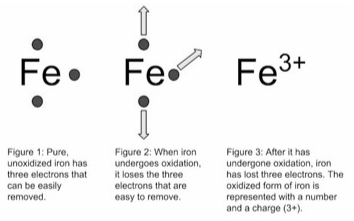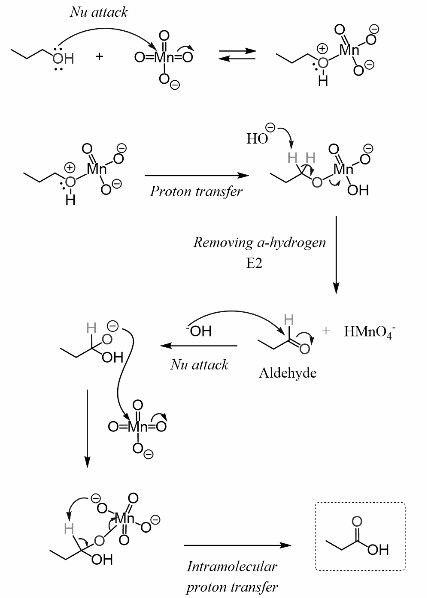When an atom, a molecule, or an ion loses one or more electrons in a chemical reaction, it is said to be oxidation.There is an increase in the oxidation state of a chemical species when it undergoes oxidation.Oxidation does not always require the compulsion of presence of oxygen.
Definition of Oxidation
The properties of an atom or compound alter as it is oxidised. When an iron thing, for example, gets oxidised, it is altered because electrons are lost. Oxidized iron is a brittle, reddish powder, whereas unoxidized iron is a strong, structurally sound metal. An atom of iron being oxidised is seen in the image below:

When iron is oxidised, it takes on a charge. It now has a positive charge of three due to the loss of three electrons. The number three and a positive sign (3+) printed as a superscript to the right of the Iron (Fe) symbol denote this positive three charge.Because iron is rapidly oxidised, it’s critical to keep it out of the air and away from moisture. Iron will continue to be used.
Cause of Oxidation
The reason for oxidation is straightforward. When an atom, a molecule, or even an ion comes into contact with oxygen, it undergoes oxidation. It transfers electrons and modifies its structure in its electron shells as a result of this. Atoms trying to get valence shells with a full set of electrons is the main cause of any chemical process, including oxidation. The species’ stability is improved by this optimal configuration.Because oxygen is a reactive element, this stable electron number in atoms can be obtained through a reaction with oxygen. Oxidation occurs when elements or compounds come into contact with oxygen and react.
Oxidation State
The oxidation state, also known as the oxidation number, is the charge that an atom would have if all of its links to other atoms were entirely ionic. It refers to how much an atom in a chemical compound has been oxidised (lost electrons). The oxidation state can theoretically be positive, negative, or zero. Although totally ionic bonds do not exist in nature, many bonds have high ionicity, making oxidation status a good predictor of charge.The oxidation state of an atom has nothing to do with its “real” formal charge or any other atomic attribute. This is especially true at high oxidation states, when the ionisation energy necessary to form a multiply positive ion exceeds the energies available in chemical reactions.
Furthermore, depending on the electronegativity scale employed in their computation, the oxidation states of atoms in a particular compound may differ. It is, nonetheless, crucial to comprehending inorganic compound nomenclature rules. Several observations about chemical reactions can also be described in terms of oxidation states at a fundamental level.
What Are Oxidation Numbers?
How do you identify the oxidised substance, the reduced substance, and the reducing and oxidising agents in a chemical reaction?According to the notion of redox reaction, such identification can be done by determining which material is transferring electrons to other compounds. This explanation in terms of electron loss and gain, on the other hand, only applies to ionic compounds with complete electron transfer and excludes other reactions, such as:
N2 + O2 → 2NO
H2 + Cl2 → 2HCl
During the formation of molecules like NO and HCl, no electrons are transferred from one atom to another. In this case, the previous definition of a Redox reaction will not suffice. As a result, chemists find that adopting the concept of oxidation number makes it easier to keep track of the electrons in such reactions.
By the evaluation of its surroundings, an atom can be assigned as a negative, positive, or zero oxidation number. Oxidation values can also be fractional in some cases.
Oxidation Mechanism
The loss of negative electrons during oxidation transforms neutral entities with the equal number of positive and negative charges into positive ions. The transmission of electrons between molecules occurs in biological activities as well, aided by enzymes. The ease with which electrons are lost determines how easily an atom can be oxidised.
The ease with which an atom takes one or more electrons is measured by its reduction potential. Metals have low reduction potentials because they tend to lose electrons.A magnesium atom, for example, has two valence electrons that it rapidly loses to produce a magnesium ion with two positive charges.The reduction potential of this metal, as well as all other metals, is typically minimal.
Electronegativity is a property that describes how well a bound pair of electrons is attracted to an atom of an element.Metal atoms have no attraction to electrons. As a result, metals’ electronegativity levels are low. The values of electronegativity range from zero to four. The non-metal fluorine has the highest electronegativity value, indicating that it has a strong affinity for electrons.Oxidation is thought to occur in elements with low reduction potentials and electronegativity values.
Example of oxidation mechanism
Oxidation of Alcohols by Potassium permanganate – the Mechanisum

Conclusion
The phrase and phenomena of oxidation is well-known.When metal objects tarnish, when iron objects rust, when substances like hydrogen peroxide are used to clean wounds, and when fruits turn brown and squishy, oxidation happens.The process of oxidation is a chemical one. When a chemical species obtains oxygen or loses hydrogen, this is referred to as oxidation. Oxidation occurs when these events occur. In a nutshell, oxidation occurs when a substance undergoes a chemical change, or when oxygen or electrons are added or lost. The transport of electrons or oxygen is involved.
 Profile
Profile Settings
Settings Refer your friends
Refer your friends Sign out
Sign out






